After all my years of trying them at restaurants and reporting on them in these pages, I sure hope you know what pelmeni are. One of Russian cuisine’s most famous dishes, eaten in homes all over the former Soviet Empire, and in Russian eateries around the world. But where do those meat dumplings come from? “Siberia!” some might exclaim triumphantly, not questioning how one of the least populated and most climatically hostile regions in the world gave birth to a dish that’s made of ingredients generally farmed thousands of kilometers away (just look at this map of wheat production in Russia), or wondering how the dish managed to gain global renown despite such unfavorable circumstances. This sure requires some explanation.
The word pelmeni is derived from pelnyan (пельнянь), which literally means “ear bread” in the Finno-Ugric Komi and Udmurt languages. With this piece of knowledge, it’s fair to claim that they come from Udmurtia, the Komi Republic, and the Perm region. None of which are in Siberia, mind you, but in the Ural Mountains (whence they most likely spread to neighboring Siberia later on). And none of which are famous for their wheat silos, either. Or their cows. Or their pigs. I’m not saying you wouldn’t have found any of those things there a few centuries ago, but they would have been in too short supply to become the bases for a local specialty.
So if the name was coined in the Urals, the idea of boiling ground meat wrapped in dough likely originated even further afar. While nothing is certain, the most logical candidate is the Chinese wonton: there are many kinds of wontons, but some of them exhibit very similar dough, filling, shaping, and cooking. And yes, to get to the Urals from China, you might cross a part of Siberia. Or you might cross Kazakhstan instead, where tushpara are dumplings almost identical to pelmeni, save for the meat blend. Uralic, Chinese, Siberian, Kazakh, take your pick…

What is clear is that pelmeni proved to be a particularly effective means of preserving meat during long winters, especially in terms of eliminating the need to keep livestock during those cold months. Hunters or explorers heading into the taiga would carry sacks of frozen pelmeni among their provisions: easily cooked, somewhat nonperishable food. The fact that pelmeni required just a thin layer of dough was also a clear advantage, as flour could be pretty rare.
In the early 19th century, pelmeni were still confined to Ural-Siberian cuisine. Most Russians had only started hearing of them via books, if at all. These books were typically dictionaries of regional words or collections of regional stories, simply giving definitions of the words. The most famous is Ekaterina Avdeeva’s Notes and Remarks about Siberia, published in 1837, in which it is explained that pelmeni “are made from pasta dough, with chopped beef, fish or mushrooms; they are frozen and they become stones”:

This is not to say that Russians had never heard of meat dumplings before. They were fully aware that various peoples around them ate boiled meat dumplings, such as those in the Caucasus or Central Asia (manty were already known of in Russia as far back as the 16th century). But these dishes all had different names and were shrouded in a veil of exoticism; most people hadn’t tried them firsthand. Russians knew varenyky as well, but traditional varenyky weren’t filled with meat (don’t forget: tradition is the mother of ignorance).
But then, bam! Pelmeni burst out of Siberia and garner nationwide fame. How? Well, this is a consequence of the Industrial Revolution. Railroads, human migrations, and mass book printing mean that regional traditions can finally go national. The food trade likewise goes national, and goods can now be shipped around the country. At the same time, the Slavophile movement in the 1850s and ’60s brings attention to old dishes and traditions. Pelmeni are a perfect fit because they’re rich in history, low-cost, easy to make, and equally suitable for eating at home or eating out — and there’s nothing like a dish with a Finno-Ugric name to boost a Slavophile movement, right? 1855 sees the publication of Ignati Radetski’s The Gastronomes’ Almanac, including one of the first pelmeni recipes to be found in print. The dumplings consist of pasta dough and a filling of pork, deer, and onion. Radetski places on each disc of dough an amount of stuffing the size of an egg yolk, and shapes the pelmeni like half-moons. Is the half-moon shape more authentic, or just easier to make? Or is it favored by Radetski for some other reason? Who knows.

As they say, the rest is history. If you read Russian, you can consult this excellent blog for more information, not only about pelmeni but about Russian cuisine in general. In modern Russian culture, store-bought pelmeni are considered a convenience food and are associated with student or bachelor lifestyles, because even the most inept cook can boil some dumplings in a pot of water. If that’s still too hard, one can always call Russian fast food chains like this one to the rescue. On the other hand, let’s look at some cookbook recipes…
In his Cookbook of the Soviet People, Poklhebkin gives us the recipe for real Perm pelnyani — that’s his only pelmeni recipe in the book. The stuffing consists of beef, lamb, and pork, plus onion, egg, flour, nettles, and goutweed. The dough is rolled as thin as possible, shaped like tortellini, and each dumpling is rather small (filled with 1 teaspoon of meat). The pelnyani are boiled in meat broth or water with onion, bay leaf, and parsley. The slightly bizarre choice of ingredients might resonate with a word of caution straight from Wikipedia: it has been emphasized by different authors that books by Pokhlebkin contain a large number of basic mistakes, including wrong concepts and invented facts.
In The Food and Cooking of Russia, Lesley Chamberlain paints a colorful picture of the Siberian pelmeni-related mores:
It is said that whole villages still turn out one afternoon before the onset of winter to make a vast batch of pelmeni. The women make the dough and chop the meat, the men do the folding. For their exacting work the latter enjoy a glass of vodka every hundredth pelmen. […] The villagers have an immediate feast after their work, with which ice-cold vodka is obligatory. The rest of the pelmeni are deep frozen in goatskin bags in the snow. Pelmeni-eating constests take place periodically.
Was this ever true, or does Chamberlain share with Pokhlebkin a fondness for spinning yarns? I can’t tell. Somehow I would imagine that the women would take care of the dough, the filling, and the folding, while the men would drink the vodka, 100th pelmen or not. And now they all drink vodka because they already have store-bought pelmeni in the freezer. Chamberlain’s recipe itself is pretty basic.
Lastly, I’ve recently acquired the beautiful Russia’s Cooking: Tradition and Modernity. Its authors claim that the standard pelmeni filling is beef, lamb, and pork (like with Poklhebkin) because “this unity of meats for ancient Urals symbolized the sacrifice of all domesticated animals to the gods.” This could be true, or it could be that right now someone’s laughing their ass off somewhere in the Urals at the thought that they managed to get this absurd story into print. Regardless, this cookbook does seem to have a few good tricks up its sleeve, such as using meat broth for extra juiciness (though I’d already figured that out), and a little bit of flour “to add viscosity to the meat.”
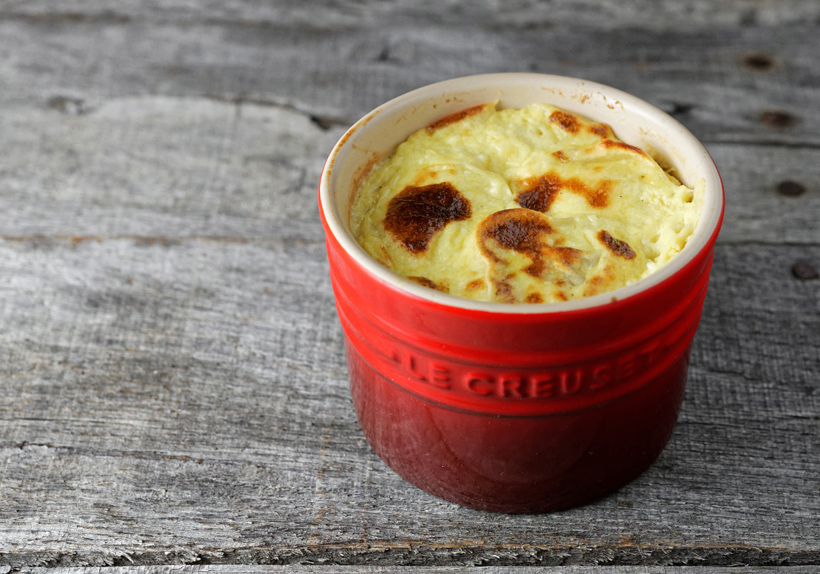
Faithful readers will recall my common complaints about pelmeni in restaurants: the filling’s too dense, the meat’s not juicy enough, the dough’s too thick, the dumplings are dry. Then, sometimes the dumplings are just perfect. Finally, it’s time to see how well I fare cooking my own. I first created this recipe a long time ago, but got so tired of eating dumplings that I stopped just short of finishing it. Picking it up again now, I realize that all my efforts payed off: these are some addictive pelmeni.
- Cut them in half, and juice oozes out. There’s a very good reason for that: I add reduced stock to the meat!
- They’re quite large (about the size of Ignati Radetski’s 1855 exemplars) because I find that this increases the meat-to-dough ratio. And really, I suspect that many versions, especially the commercial ones, are smaller simply because they’re made on Italian tortellini machines.
- I roll the dough as thinly as I can, which is also historically accurate (since flour was scarce), but the dough recipe itself is richer than most. I use a lot of eggs and butter, trying to achieve an empirical balance between softness, elasticity, and flavor.
- Finally, while some people like cooking pelmeni in meat broth, I’m getting an even more flavorful result by finishing them in a sauce of reduced beef stock, butter, and cream — just like you would finish a pasta dish in a pan with the sauce.
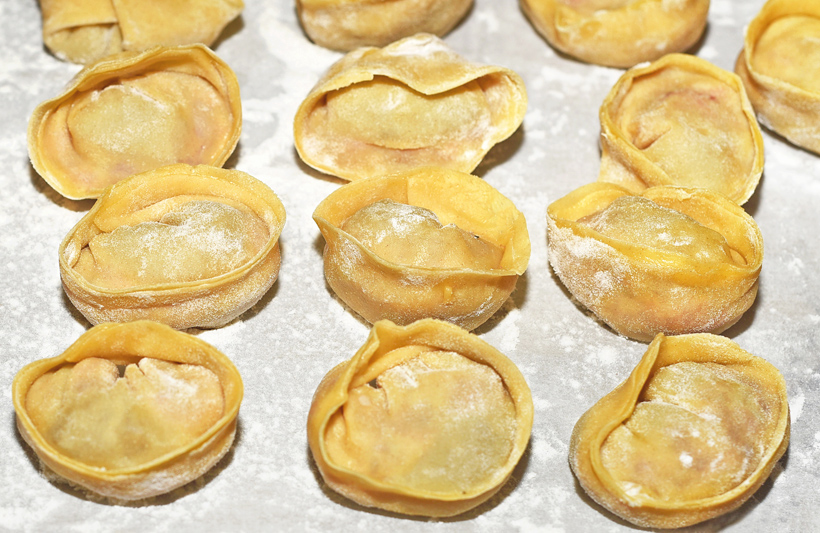
What was missing from my initial recipe was an interesting way to finish the dish. Traditionally, cooked pelmeni are served in broth, on their own or topped with melted butter or sour cream. Mustard, horseradish, tomato sauce, and vinegar are also popular. So I decided to make three versions, inspired by several of those garnishes:
- First there’s the pelmeni au naturel, tossed in my stock-butter sauce (as all three versions are), but simply finished with chopped scallions and grated lemon zest. Simple, but not necessarily any less good.
- The second version is topped with a vodka hollandaise, an excellent variation on the egg white hollandaise that I’ve published here. If you’ve ever tried pelmeni with vinegar, this sauce offers the benefits of that pairing in a more subtle package, and you can even think of the hint of booze as a wink to Chamberlain’s Siberian tales. With the hollandaise, 6 pelmeni are enough for a portion, and 4 would make a good appetizer.
- Thirdly, some New York restaurants propose pelmeni baked with eggs, cheese, and dill, especially for brunch. This has been dubbed “Moscow style” pelmeni (just go to Masha and the Bear on a weekend to try it). I’ve never been a fan, and I don’t quite understand where the name comes from because I’ve never seen this in Moscow, but I do know Muscovites who will dump whatever they have in their refrigerator into a pan with eggs and cheese. Additionally, the late lamented Moscow 57/Kapowski’s came up with what I thought was a brilliant idea: pelmeni covered with tomato sauce and cheese, lasagna style. Long story short, this all reminded me of achma, the Georgia cheese lasagna, and wouldn’t it be great if we could combine delicious dumplings with Georgia’s propensity for salty cheese overdose? It’s pelmeni! It’s achma! It’s pelachmeni!
I encourage you to try the trio, though I understand that this is a considerable culinary undertaking. Don’t hesitate to team up with your significant other to make a large batch of pelmeni, which you can then freeze. Then you’re left with only a couple of sauces to prepare.
As usual there’s always more things that one could try. Does Serious Eats’ pasta dough work better than mine? Does flour really “add viscosity to the meat” and is that any less yucky than it sounds? Should we all start foraging for nettles and goutweed? Will God really like me more if I slaughter half of Creation’s animals to make dumplings? Maybe I’ll give you an answer in another five years.

Beef stock
Yields about 950 g (enough for over 40 pelmeni)
500 g oxtail
salt
15 g olive oil
75 g peeled carrot, large dice
75 g celery, large dice
150 g peeled onion, large dice
2 g peeled garlic
1 clove
2 peppercorns
1 juniper berry
3 thyme sprigs
1/2 bay leaf
900 g water
- Season the oxtail with salt. In the pot of a pressure cooker over high heat, sauté the oxtail in olive oil until brown on all sides. Add the carrot, celery, onion, and garlic, and stir for 2-3 minutes.
- Add the clove, peppercorns, juniper berry, thyme, bay leaf, and water. Cover, bring to pressure, then cook under pressure for 1 hour.
- Let cool for 30 minutes, and pass through a chinois, discarding the solids. Transfer to pint containers, and refrigerate for at least 12 hours.
- Once the stock is cold, remove the congealed fat from the surface.
Pasta dough
Yields about 40 pelmeni (+ scraps)
300 g flour (sometimes slightly more, see below)
3.5 g salt
140 g (about 3) eggs
20 g (about 1) egg yolk
25 g butter, melted
- In the bowl of an electric mixer fit with the paddle attachment, place half of the flour, plus the salt, egg, and egg yolk. Mix over low speed until homogeneous, scraping down the sides with a spatula. Add the rest of the flour and the melted butter, then mix again until it forms a smooth paste.
- Transfer to a floured surface, and knead with your hands for about 3 minutes. If necessary, add a little bit more flour until the dough doesn’t stick. Wrap in plastic and let rest for 30 minutes.
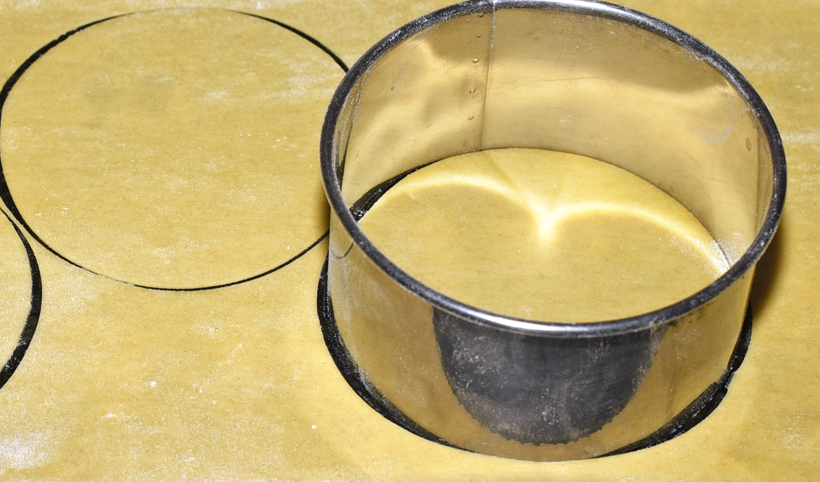
Pelmeni filling
Yields about 40 pelmeni
350 g beef stock
0.1 g agar agar
25 g butter
120 g peeled shallots, thinly sliced
8 g peeled garlic cloves, thinly sliced
1 g star anise, ground
240 g beef short ribs, boneless
240 g pork belly, boneless, with about 50% fat
7 g salt
0.3 g black pepper, ground
- In a saucepan over high heat, reduce the beef stock to 1/3. Mix in the agar agar, then remove from the heat and transfer to a plastic container. Let cool and refrigerate for a few hours, until set.
- Melt the butter in a saucepan over medium heat, and sauté the shallots and garlic in the butter until soft. Add the star anise, and cook for about 10 minutes, stirring regularly, until caramelized. Let cool and refrigerate.
- Cut the beef and pork into large dice, and season with the salt and pepper. Pass the meat through the large die of a meat grinder into a bowl. Add the reduced stock and the shallot mixture, mix with a spatula, and then grind again, this time using the small die of the grinder. Refrigerate until very cold.
Pelmeni
Yields 40 pelmeni
20 g egg yolk
20 g water
pasta dough
flour, for dusting
pelmeni filling
- Mix the egg yolk and water in a small bowl to make an egg wash.
- Divide the dough into four batches, and proceed with one batch at a time through the following steps, keeping the rest of the dough covered with plastic wrap (this prevents the dough from drying and breaking when you shape the pelmeni).
- Using a pasta machine, roll the dough to the thinnest setting, and keep on a floured surface. Using a ring mold, cut into discs of 9 cm diameter.
- Brush each disc with egg wash and place about 15 g of meat filling in the center. Fold in half, and seal the edges with your fingers — now you’ve got half moons. Join the two tips, as in Italian tortellini, and pinch them together. Keep the pelmeni on a sheet tray dusted with flour.
- The pelmeni can be transferred to a freezer bag and frozen. The scraps of dough can be reused: gather into a ball, optionally vacuum-seal in a sous-vide pouch and let rest 30 minutes, then roll in the pasta machine and make long noodles.
Assembly for pelmeni au naturel
Yields 2 servings of 8 pelmeni
100 g beef stock
10 g heavy cream
10 g butter
16 pelmeni
salt
scallion greens, chopped
1/2 lemon
- In a pan over medium heat, reduce the beef stock by 2/3. Whisk in the cream and butter, and simmer for a couple minutes, until the sauce coats the proverbial back of a spoon. Cover and keep warm.
- Boil the pelmeni in salted water until the dough is very soft.
- Take the pelmeni out of the pot with a skimmer, and transfer to the pan of sauce. Coat the dumplings in the sauce over low heat for a minute.
- In each bowl, place eight pelmeni, and drizzle with a little bit of sauce. Sprinkle with scallion greens and a little bit of lemon zest grated with a Microplane grater.
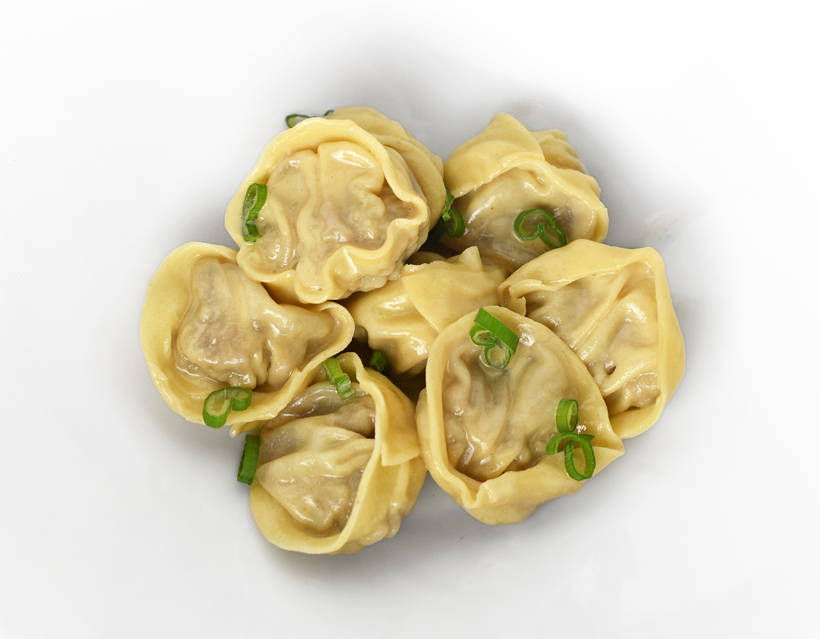
Vodka hollandaise
Yields about 2 servings
55 g Champagne vinegar
30 g peeled shallots, thinly sliced
110 g egg whites
50 g butter, sliced
40 g milk
4 g salt
25 g vodka
1 g xanthan gum
- Combine the vinegar and shallots in a small saucepan, and reduce by half over high heat.
- Strain the vinegar reduction, and weigh 23 g of the liquid, discarding the rest.
- Place the vinegar reduction, egg whites, butter, milk, salt, and vodka in a sous-vide pouch. Cook in a 75 C / 167 F water bath for 25 minutes.
- Transfer the contents of the pouch to a blender, add the xanthan gum, and blend on medium speed for 1 minute.
- Transfer to a 1 liter siphon, and charge with two cartridges of N2O. Shake several times, then reserve in a 65 C / 150 F water bath until serving.
Assembly for pelmeni with vodka hollandaise
Yields 2 servings of 6 pelmeni
80 g beef stock
8 g heavy cream
8 g butter
12 pelmeni
salt
vodka hollandaise
scallion greens, chopped
1/2 lemon
- In a pan over medium heat, reduce the beef stock by 2/3. Whisk in the cream and butter, and simmer for a couple minutes, until the sauce coats the proverbial back of a spoon. Cover and keep warm.
- Boil the pelmeni in salted water until the dough is very soft.
- Take the pelmeni out of the pot with a skimmer, and transfer to the pan of sauce. Coat the dumplings in the sauce over low heat for a minute.
- In each bowl, place six pelmeni. Cover with vodka hollandaise using the siphon. Sprinkle with scallion greens and a little bit of lemon zest grated with a Microplane grater.

Assembly for Pelachmeni
Yields 2 servings
150 g fresh mozzarella
55 g (about 1) egg
20 g (about 1) egg yolk
40 g heavy cream
100 g Bulgarian feta
salt
black pepper, ground
100 g beef stock
10 g heavy cream
10 g butter
16 pelmeni
- Slice the mozzarella, and drain on paper towels for 5 minutes (this left me with about 140 g).
- In a blender, process the egg, egg yolk, heavy cream, mozzarella, and feta on medium speed for a few seconds, then on high for a split second. The cheese mixture should be liquid with a few small chunks. Season with salt and pepper, and reserve.
- In a pan over medium heat, reduce the beef stock by 2/3. Whisk in the cream and butter, and simmer for a couple minutes, until the sauce coats the proverbial back of a spoon. Cover and keep warm.
- Boil the pelmeni in salted water until the dough is very soft.
- Take the pelmeni out of the pot with a skimmer, and transfer to the pan of sauce. Coat the dumplings in the sauce over low heat for a minute.
- In each of two small stoneware cocottes (about 10 cm diameter, 7.5 cm tall), pack 4 pelmeni, top with some cheese sauce, then add 4 more pelmeni and the rest of the cheese sauce. Bake in a 225 C / 450 F oven for 8 minutes, then broil until the top turns a nice brown color. Serve immediately.
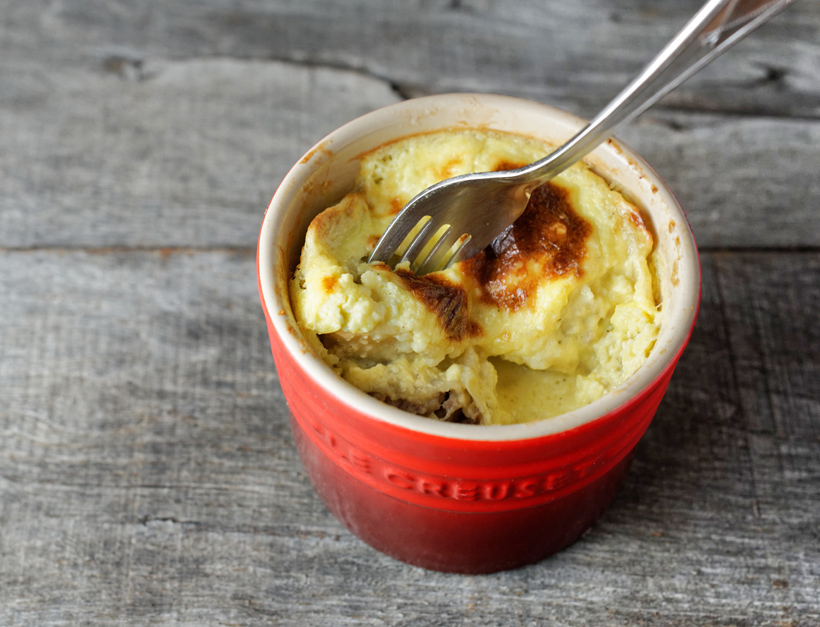







12 comments
Great post! Very well explained and more! 🙂
Interesting…my pelmeni experience (Moscow, Lake Baikal, Tbilisi) has almost always involved dill, but I’ve never seen it with cheese (always smetana or a more complex sauce like yours). Usually I don’t like dill, but this is one of the few dishes in which it works for me.
True! Dill is to Russian savory food what cinnamon is to American desserts… I don’t necessarily dislike either, but there’s no reason to use them in massive amounts all the time.
Several years ago I was in Kamchatka and ate dumplings filled with potatoes, no meat. They were incredible! Wish I had the recipe.
Hi Martha, this sounds a lot like varenyky. Recipe here!
Look for Pierogi in any Costco.
This is where every chef should be . Great posts always. Bon Courage! .Thank you Mr Florian you are the best.
I love to eat pelmini with butter, soy sauce and black Chinese vinegar 🙂
Omfg, thank you for mentioning this. I had glanced at the Chinese black vinegar in my cupboard and had a moment of intrigue, but didn’t take it seriously. I just had them with butter, black vinegar, soy sauce, and homemade chili oil, and OH MY GOD. Heaven.
I have read many recipes saying it is common to eat pelmeni with vinegar. Is it customary to sprinkle it on top, dip it? I would love to know, also what type of vinegar. Thank you for any info about this! 🙂
Hi Kin, it’s not really my thing, but drizzling some sort of white vinegar on top of your pelmeni is indeed quite common.
When I was last in Moscow (about 25 years ago) the pelmeni in restaurants was always served in a thin creamy sauce which I thought was beef broth and possibly Greek yoghurt. I’m going to try your sauce a little runnier to go for that because I loved the dish. Thank you for the palmeni recipe.